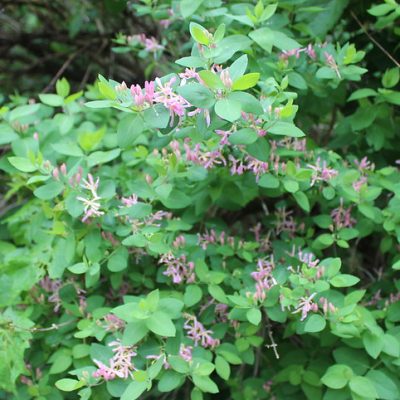Invasive Plants Workshop and Tool Lending Library

Conservation Commission Member testing the Extractigator

Tatarian honeysuckle, a common Cornwall invasive
Invasive Plants: Find ‘Em and Do ‘Em In! was the title of an August ’22 workshop led by Travis Hart, Habitat Biologist from the Vermont Department of Fish & Wildlife. Travis may have been the workshop presenter, but there was a second attraction that brought people out: a set of hand tools that are used to manually remove tough invasives. Their fierce names, Predator, Uprooter and Extractigator, offered hope to attendees. The tools had been purchased by Conservation Commission and were to be available for borrowing by residents (see Tool Lending Library list below).
The list of the Champlain Valley non-native plants is a long one. As a group, where they spread freely, invasive plants quickly outstrip native vegetation and suppress its regeneration. Travis talked about why it is important to remove them from our yards, meadows and woods. Among other problems, they are a poorer food source for animals. The fruit of honeysuckle is, for example, much less nutritious than that of the native dogwood and has been likened to the eating of junk food. Interestingly, most birds and other animals prefer to feed on their ecological partners, native plants, if given a choice.
Travis made clear that control, not eradication, is the long-term objective for most of us. Once they have taken hold, invasives are not easy to remove and seeds from these plants remain viable in the ground for years. In terms of their control, he described both chemical and manual methods that are available to the homeowner.
Much depends on the kind of invasive and its area of impact. For example, hiring a certified professional to apply herbicides may make sense if the infestation area is large. But a landowner can also treat shrubs or trees on their property by individually cutting and applying herbicide to the stumps. On the other hand, manual pulling of garlic mustard is probably the best approach. vtinvasive.org is an excellent resource that can help landowners identify and choose the best treatment options.
The workshop ended with some hands on experience with the tools. Travis showed how the Parsnip Predator shovel made cutting the individual roots of parsnip plants easy. It is effective if used before the seed heads begin to form. Then participants grabbed the big tools, 2 Uprooters and 2 Extractigators that are designed to remove small to medium-sized shrubs, and headed to a nearby strip of buckthorn and honeysuckle to put them through their paces. They worked!
Additional Useful Information:
Travis Hart is available to work with private landowners on their property on invasive control and improving wildlife habitat. Email: travis.hart@vermont.gov.
Chittenden County Forester Ethan Tapper has made a short video to demonstrate how homeowners can effectively use herbicides in a targeted application. https://tinyurl.com/mkbnm4jd
Cornwall Tool Lending Library:
Available for community borrowing from the Cornwall Library.

Uprooter
Place jaws of Uprooter around stem of plant; pull lever.
15 pounds; 52” height. 2 ¼” jaw opening. theuprooter.com

Extractigator Junior
Removes saplings & small trees up to 1.5” diameter.
9 ¾ pounds; 36” height. https://www.extractigator.com

Extractigator Baby Gator
Removes plants up to 1” diameter, but recommended for ½” diameter plants. Especially helpful for bank or hillside plant removal.
7 pounds; 24” in height. https://www.extractigator.com

Weed Wrench Light
A light-weight tool that allows standing while removing plants up to 1.5” diameter.
10 lbs; 43" height. theuprooter.com

Parsnip Predator
Lightweight specialty shovel with narrow, notched blade at tip for easier centering on the root. A slicing tool, not for prying. www.theprairieenthusiasts.org/parsnip_predator
